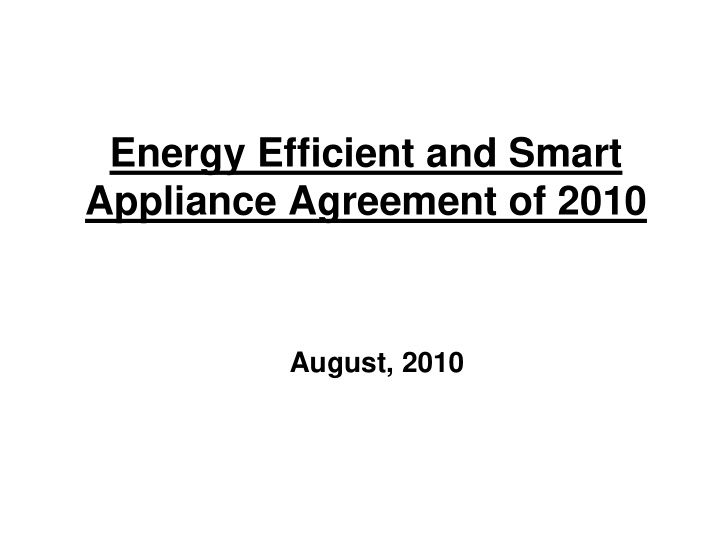



Energy Efficient and Smart Appliance Agreement of 2010 August, 2010
Supporters Association of Home Appliance Manufacturers (representing GE, Whirlpool, Electrolux and 23 other companies) American Council for an Energy-Efficient Economy Appliance Standards Awareness Project Natural Resources Defense Council Alliance to Save Energy Alliance for Water Efficiency Northwest Power and Conservation Council Northeast Energy Efficiency Partnerships Consumer Federation of America National Consumer Law Center California Energy Commission Demand Response and Smart Grid Coalition Earthjustice
Agreement Overview SAVES ENERGY/INCREASES ENERGY INDEPENDENCE – Improves product energy efficiency and saves more than 9 Quads of energy over 30 years (U.S. uses ~100 quads) SAVES WATER – Requires and incentivizes clothes washers and dishwashers to use nearly 5 trillion less gallons of water over 30 years REDUCES GHG EMISSIONS – 30-year savings ~550 MMT CO2 SAVES CONSUMERS MONEY – ACEEE estimates present value net savings to consumers of nearly $30 billion (from products sold 2013-2030) SMART GRID AND ENERGY STAR – Jump-starts the Smart Grid by helping to deploy smart appliances nationwide and enable consumers to better take advantage of demand-response and real-time pricing opportunities – Recognizes smart appliance contributions through ENERGY STAR
Agreement Overview JOBS – Impacts 46,000 manufacturing jobs (19,000 direct; 27,000 supply chain/support) and creates new jobs, including bringing back to the U.S. jobs that were outsourced in earlier years MANUFACTURER INCENTIVES – Incentivizes manufacturers to increase the production of super- efficient products—over and above ENERGY STAR levels— thereby saving even more energy and water and encouraging more job creation DOE EFFICIENCIES – Frees up resources now devoted to rulemakings on these products
New Refrigerator Standards • 20-30% energy savings relative to current standards for major product categories. • New standards take effect Jan. 1, 2014 • DOE to develop new test procedure to measure ice-maker energy use by Dec. 31, 2012. This is used for standard effective ~2016.
Refrigerator/Freezer Energy Savings by Category % Savings Classes 30% Auto defrost freezers 25% Top-mount and side-by-side R/F Manual defrost freezers 20% Bottom-mount R/F 10-25% Various smaller categories Standards are 5% lower for built-in units
New Clothes Washer Standards • Initial standards effective Jan. 1, 2015 • Different standards for top-loaders and front-loaders – Top-loader standards have two phases • Front-loaders: 43% energy savings and 52% water savings relative to current standard • Top-loaders: 26% energy savings and 16% water savings (2015), 37% energy savings and 37% water savings (2018)
Clothes Washer Standards (MEF/WF) Category Current 2015 2018 Standard Standard Standard Top-load, 1.72/8.0 2.0/6.0 std size 1.26/9.5 Front-load, 2.2/4.5 Std size Top-load, 0.65/18.4 1.26/14.0 1.81/11.6 Compact Front-load, N/A 1.72/8.0 Compact
Clothes Dryer Standards • 5% energy savings using current test procedure. • In addition, test procedure modified to address effectiveness of auto termination. This provides significant additional energy savings from reduced over-drying. • Standard takes effect Jan. 1, 2015
Room Air Conditioner Standards (Effective June 1, 2014)
Dishwasher Standards • Improve efficiency of standard and compact dishwashers. – Standard units to 307 kWh/yr, 5.0 gal/cycle – Compact units to 222 kWh/yr, 3.5 gal/cycle • Same as the July 2011 ENERGY STAR specification • Reduces energy use 14% and water use 23% • Takes effect Jan. 1, 2013
Smart Appliances • Parties will jointly petition EPA to provide a 5% credit on energy use for products that meet an EPA-set definition of “smart appliance”. – Will include ability to push some energy use to off-peak periods when receive a signal from the utility. • Parties will also work together to develop a proposal for tax or other incentives for appliances with “smart” capabilities.
Proposed Tax Incentives (extension of current incentives that expire 12/31/10) auto defrost auto defrost
Energy and Water Savings from Standards Source: LBL analysis except for dryer TP which was estimated by ASAP.
Costs and Benefits of New Appliance Standards 18.0 16.0 $ billion (PV, for products sold thru 2030) 14.0 Costs 12.0 Benefits 10.0 8.0 6.0 4.0 2.0 0.0 Refrigerators Freezers Clothes Clothes Dryers Room AC Dishwashers Washers Source: ACEEE
Recommend
More recommend